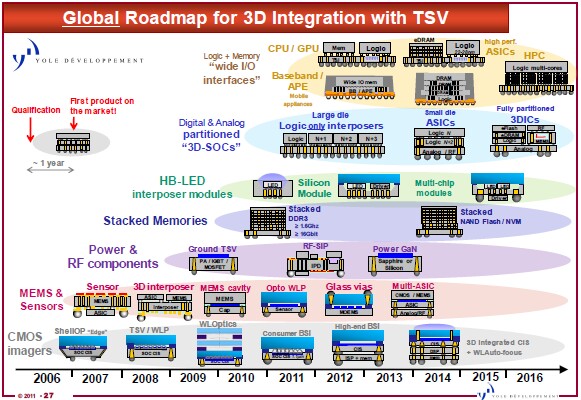upnorthsox
Veteran
I can't seem to find it now, but someone was asking about stacked/interposer timetable. Here's a couple more references.
Hynix's outlook:
And another roadmap:

The interesting thing to note on the roadmap is that Sony (and their manufacturing partner Toshiba) dominate the 2 lower categories, cmos imagers and MEMS sensors. They are also now involved with Power & RF components. While they aren't involved with manufacturing memory, they would be considered a large consumer and thus an influencer in that category which also ties back to the top category which is what has been discussed here as also a Sony interest.
All in all when looking at this roadmap, it's no wonder why Sony would be mentioned as being active.
Hynix's outlook:
Kim said that critical to lowering cost will be depreciation (of equipment) and improved yield. Design optimization will help as well as reducing process turn-around time to increased productivity. He shared Hynix 3D roadmap, saying that volume TSV production will officially start after 2013:
DRAM on Logic for mobile applications in a known good stacked die (KGSD) driven by form factor and power, are in development in 2012 with low production expected early 2013 ramping to volume late 2014.
DRAM on interposer in a 2.5D configuration for graphics applications, driven by bandwidth and capacity is in development in 2012 with low production expected by the end of the year and ramping to HVM early in 2014.
3D DRAM on substrate for high performance computing (HPC) driven by bandwidth and capacity is in development in 2012, with low production expected early 2013, ramping to volume late 2014.
And another roadmap:

The interesting thing to note on the roadmap is that Sony (and their manufacturing partner Toshiba) dominate the 2 lower categories, cmos imagers and MEMS sensors. They are also now involved with Power & RF components. While they aren't involved with manufacturing memory, they would be considered a large consumer and thus an influencer in that category which also ties back to the top category which is what has been discussed here as also a Sony interest.
All in all when looking at this roadmap, it's no wonder why Sony would be mentioned as being active.

 [it has to be a missquote, 200w gpu fits]
[it has to be a missquote, 200w gpu fits]